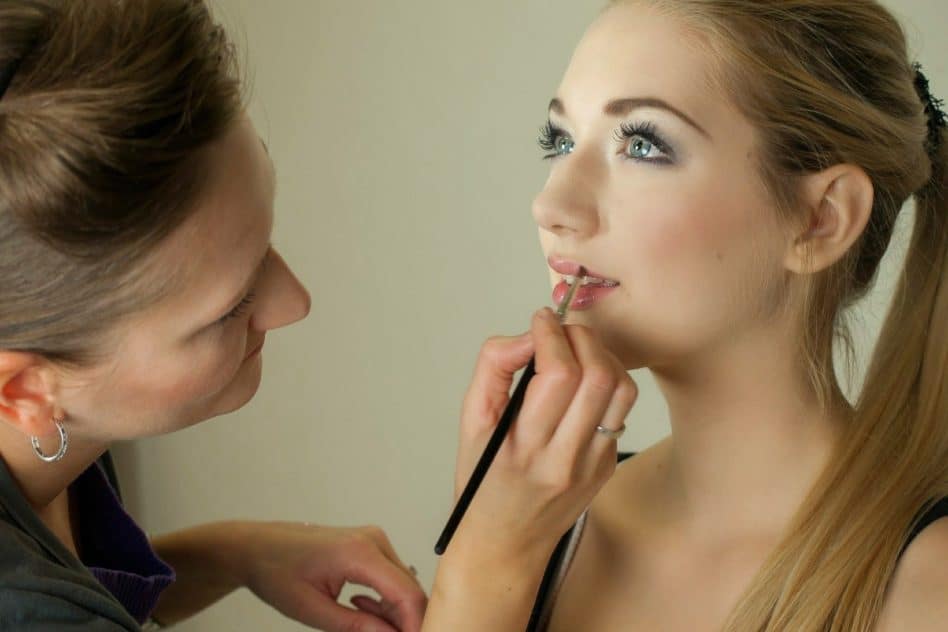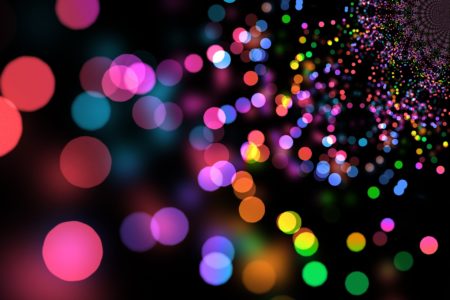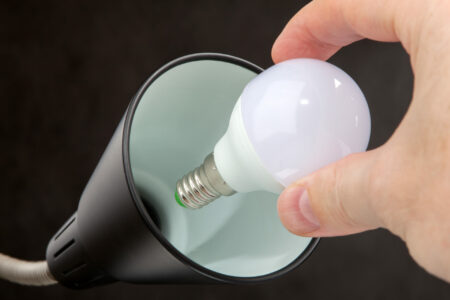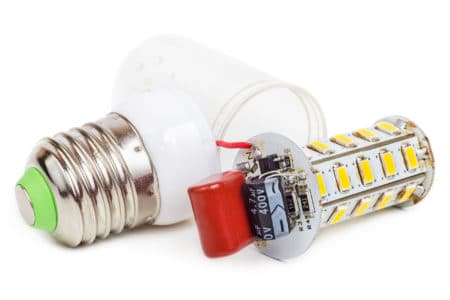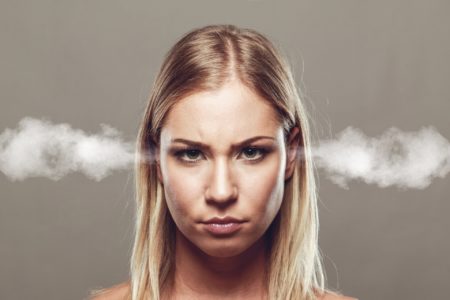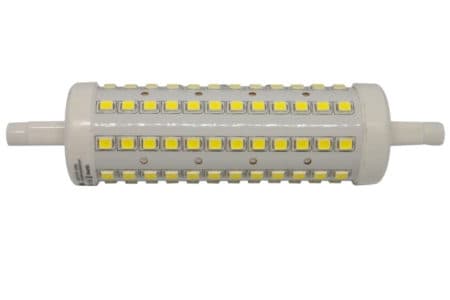Today LED technology is very common for lighting your home. Other than incandescent bulbs, LEDs have many different characteristics, so you may wonder if LED lighting is good for applying makeup. Especially the color temperature stands out, as it affects the hue of the emitted light. In this guide you will learn all important factors so you don’t apply the wrong tone of makeup due to inappropriate LEDs.
LED Lighting vs Applying Makeup
You are probably familiar by applying makeup with traditional lighting of incandescent bulbs. Here you know every shades and colors and how they look afterwards in a daylight atmosphere. With modern LED lighting things become a little bit more difficult as there are more technical characteristics you need to pay attention to. Two most important one is the color temperature of a LED bulb which is measured in Kelvin (K).
Besides that there is also the brightness measured in lumen (lm) which is the equivalent to the wattage of an incandescent bulb. Although there are some other technical variables, with those two it’s enough to define if LED lighting is good for applying makeup.
How Can Light Affect Makeup?
Being aware of the different types of lighting technologies allows you to better apply and adapt your makeup. For example, if we have a strong intensity of light, the makeup tone will brighten. On the contrary, if we have low light intensity, the makeup tone will darken. All this will also depend on the hue and angle of the light.
For this reason, it is necessary to take into account what type of light is going to be used, natural or artificial, to know what tones and texture to choose.
Natural Light
Natural light always comes from the sun. It helps to see everything clearly. The recommended tones to use: warm ones and a fine and light texture. You must take into account that natural light is inconsistent, and we can experience different intensities and shades of light since it depends on the daytime and the also the actual weather.
Dawn
- Light type: Bluish
- Its fruit in makeup: The tones and textures look more intense, so the most advisable are natural tones and a fine texture.
Midday
- Light type: White
- Its effect on makeup: It does not alter the tones, its see as they are.
Sunset
- Type of light: Orange, warm
- Effect on Makeup: Any tone favors.
Rainy day
- Light type: Cold, bluish, and gray
- Consequence in Makeup: This light leaves the face pale. Cold and warm tones intensify.
Sunny day
- Light type: Yellowish and Orange
- Result in Makeup: Cold tones are aggressive and warm ones are flattering.
Artificial Light
Artificial light is everything which doesn’t come from the sun rather than from the different types of light bulbs. Here it is advisable to make facial corrections. In this case, intense tones and covering textures can be used.
Incandescent bulb light
This type of bulb emits a light of orange, red, yellow tone.
Its effect on makeup: Softens warm tones and accentuates cold tones. If red applies, make it dim; avoid orange tones; the foundation, clear and luminous but not containing pink pigment; however, a slightly pink tone can be applied in dull or yellowish complexions.
Fluorescent bulb light
This type of bulb emits a light that contains more intensity of blue than red. Activate blue and reduce colors like red. The luxury white fluorescent light or daylight is more orange and gives the face and makeup a pleasant color.
Its effect on makeup: Alters cold tones, cooling them more; it attenuates the warm tones; therefore, it tends to bluish all the tones; gives a sallow tone to the skin; yellow eyes. Applying a makeup base containing pink pigment, a pink primer, or powder with pink pigment helps correct and soften the face. The blush and lips can be applied in pink tones.
Neon light
This type of bulb emits a cold light, which alters colors and gives a yellowish tint.
Its fruit in makeup: It is advisable to avoid the use of dark, yellowish, and green tones, besides using a makeup base that contains more pink pigment, to the detriment of yellow and orange.
Candle light
This bulb type emits a warm red light that beautifies the face if it comes from the sides. If it comes from the front, it hardens the features.
It’s consequence in makeup: It diminishes all the tones. Those of the cold range, in a more subtle way, to soften the face. It is convenient not to abuse the corrections.
White light
This type of bulb emits artificial light that most closely resembles midday light.
Its effect on makeup: Similar to natural light.
Blue light
The type of bulb that emits this light builds an atmosphere of mystery.
Its effect on makeup: The effect with this light would be close to light-dark, with many shadows on the face giving the appearance of terror.
Red light
The type of bulb that emits this light creates a stale environment.
Consequence in Makeup: I would waste it because this light is stronger than any tone that we have applied.
Orange light
The type of bulb that emits this light creates a warm, relaxed atmosphere.
Consequence in Makeup: It is a good light that softens the face and reduces wrinkles. You should only avoid applying an orange tone since it would be canceled because it results in the same tone of the type of artificial light.
Pink light
The type of bulb that emits this light creates a dreamy, retentive image.
Result in Makeup: It makes it smoother and sets to eclipse, almost completely, very visible wrinkles. It is necessary to avoid applying a pink tone since this would be canceled.
What Kind of Light to Place on the Dressing Table?
With what you have read so far, you are probably wondering what is the ideal light for makeup? Surely because many times you wear makeup and you look perfect also with natural and uniform color. However, later when you look at yourself in another mirror, you discover that your makeup is not well blurred or that the color does not look as beautiful as at home. We will tell you everything about the relation between light and makeup.
Keep in mind that light is an essential aspect when doing makeup. That is why you have to be very careful with the light you use to put on your makeup, since the final result may be different from what you see at that moment. For this motive, it is advisable to choose a bright place, where the light illuminates the face and neck from all angles so that there are no shadows that can hinder the application of makeup.
From the color temperature, cold lights (higher degrees K) absorb makeup color, making the face to appear paler. Meanwhile, warm lights (lower degrees K) make you look more colorful. Therefore, the ideal light for makeup is medium-light, neither too cold nor too warm.
What is color temperature?
When choosing the perfect light for a dressing table, you mainly have to think about the color temperature. As stated at the beginning of the article, this specification is measured in Kelvin (K), and the higher the Kelvin value the colder the tonality of the light and vice versa.
Warm tone
- Kelvin: 2700 – 3000
- Atmosphere: Cozy, intimate
- Example: Evening light
Neutral tone
- Kelvin: 4000
- Environment: Fresh, clean
- Example: Midday light to neutral
Cold tone
- Kelvin: 5000 – 6500
- Environment: Dynamic, efficient
- Example: Dawn light
What Is The Best Light To Make Up?
The ideal light for putting on makeup is medium or neutral because the resulting makeup with this type of light is the one that will best adapt to any subsequent kind of light. In this sense, the color temperature that is considered ideal for a dressing table is approximately 3500 – 4000K.
Another aspect to take into account is the orientation of the light source. It always has to come from the front and never from the side or above, as this can alter the final result. You also have to be careful with the windows because artificial light can come from the front, but if we have a window on the side, it would no longer be a balanced lighting.
Now you already know what is the ideal light for makeup in general, but you may still wonder, what is with LED lighting? Is it good for makeup? The answer is: Yes! LED light is good for makeup, as long as it meets the characteristics described above.
What LED Lights for Makeup?
LED stands for light emitting diode, a light that comes from a duly energized diode, which emits light by passing current through its semiconductor element. Depending on the material (aluminum, gallium, indium, phosphor, others) of the semiconductor, it will emit light of a different color. One of the good things about bulbs with LED technology is that they consume less energy than conventional lamps.
It is essential to understand that 80% of the energy consumed by an LED is transformed into light, while in a conventional light bulb, only 20% is used to produce light and the rest becomes heat. The other interesting thing about LED bulbs is that their duration is much longer than conventional bulbs. The useful life of a bulb with LED technology exceeds 50,000 hours, while normal ones reach a useful life of around 3,000 hours.
These LEDs emit light in neutral or medium tonality which is best suited for applying makeup.
Conclusion
LED lighting is not only good for your home, it is also good for applying makeup. You just have to be careful in the selection of your makeup lights. LED lights which are emitting light in neutral or medium tonality are the best choice. They should be placed in front of you without having other bright light sources on the side.
Depending on the lighting quality where you do your makeup most frequently, it will depend how you perceive your makeup. If you are one of those who usually do makeup in front of a mirror in the bedroom or bathroom with a ceiling light or a lamp in a nearby nightstand. In that case, we hope that with the information provided, now you understand why you see your makeup differently when you later stand in front of another mirror.
If you want to have a balanced makeup, stop applying makeup in the car’s rearview mirror at the traffic light! Condition the lighting of your dressing table respecting the information provided in this article to enjoy a more professional makeup. If it is within your reach, additionally acquire a mirror with different magnifications so that you can perfect your daily artistic task.
